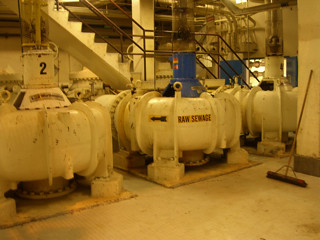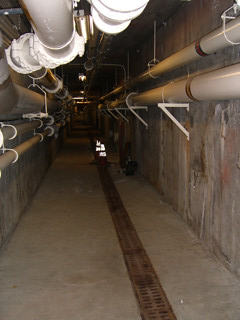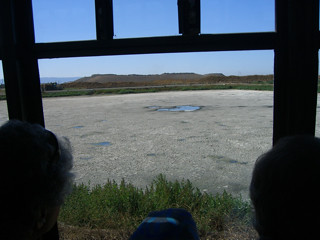CAG
Today was my first meeting of the Community Advisory Group for the Water Pollution Control Plant. Another half of the group met this past Wednesday, and we’ll all be getting together on 1 November.
Today we got a deluxe tour of the plant. Based on Pierluigi’s description of his tour, I was looking forward to the people mover, but our tour was evidently just a notch below the Council tour. We did get to see a lot more than on the regular public tour, about which I’ve already blogged.
Again, the order of the tour differed from the actual order of operations; the raw sewage seems to arrive in the middle of the plant, and follow a very circuitous route around. But we did get to go to the top of the filter building

down into the very loud basement with the sewage pumps

into some of the miles of underground tunnels

and over to the sludge-drying ponds

(that’s twelve feet deep in sludgy goodness.)
As before, the ESD employees giving the tours were very straightforward; there is no sense at all of spin or flack. The tours and the CAG have the stated purpose of building community support for the $2 billion in capital improvements that the plant needs.
My goals in participating in this group are to champion increases in the production and use of recycled water, and to advocate environmental uses for the land surrounding the plant. The Tesla giveaway is seemingly a done deal, but there needs to be some counterweight to the attitude, expressed by Tom McEnery, that “The land set aside is in the buffer area of the Water Pollution Control Plant and clearly unfit for housing or retail uses.” As if those are the only ones that count.
Of course, the CAG has no legal standing, and if City staff or the Council have already decided what the area surrounding the WPCP is going to look like, then there is not a lot that I can do to change that. But developing the new plant Master Plan is a three-year process, so I’ll at least have plenty of opportunity to have my say.
And yours. I applied for a position on this body saying that I, in some way, still represent the nearly 7,000 people who voted for me in June. So let me know what you want to see up there at 700 Los Esteros Rd.

Many in the Western World, especially the USA, think that their sewage is properly treated, but it is only treated for preventing nuisances. Like odors and as long as EPA does not consider nitrogenous waste (urine and protein) pollution, it will never even implement the Clean Water Act, as it was intended. This waste not only, like fecal waste, exerts an oxygen demand, but also is a fertilizer for algae and aquatic plant growth, causing eutrophication and eventually dead zones.
The reason EPA ignored this pollution is caused by a worldwide incorrect applied pollution test that EPA used to base its NPDES discharge permits on.
Although EPA in 1984 acknowledged this incorrect use, in stead of correcting the test, it allowed an alternative test and now officially ignored this type of pollution and by doing so lowered the goal of the CWA from 100% treatment to a measly 35% treatment, without notifying Congress.
Other problems caused by this incorrect applied test are that we do not know the real performance of a sewage treatment plants and have no idea what the effluent waste loading is on receiving water bodies, besides the possibility that such plants are designed to treat the wrong waste in sewage.
What nobody wants to acknowledge is the facts that the present intend of sewage treatment, as it was a century ago, is not the protection of ‘public health’, but the prevention of nuisances, like odors. Want to know more visit http://www.petermaier.net and read the description of this test (BOD) in the Technical PDF section.